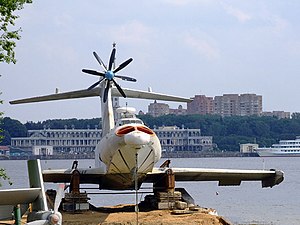

A ground effect vehicle (GEV) is one that attains level flight near the surface of the Earth, made possible by a cushion of high-pressure air created by the aerodynamic interaction between the wings and the surface known as ground effect. Also known as a wing-in-ground-effect (WIG) vehicle, flarecraft, sea skimmer, ekranoplan, or wing-in-surface-effect ship (WISE), a GEV can be seen as a transition between a hovercraft and an aircraft. The International Maritime Organization (IMO) has classified the GEV as a ship.[1] A GEV differs from an aircraft in that it cannot operate without ground effect, so its operating height is limited relative to its wingspan.
In recent years a large number of different GEV types have evolved for both civilian and military use. However, these craft are not in wide use.

Russian Ekranoplans: "LUN" / SM-6 / "Orlyonok" A-90 / VVA-14 / KM-08
In the USSR the WIG ("wing in ground effect") developments took place at the Central Hydrofoil Design Bureau (CHDB),
lead by Alexeiev. The military potential for such a craft was soon recognised and Alexeiev received personal support from Kruchev
including virtually unlimited financial resources. This very important development in WIG history lead to the Caspian Sea Monster,
v a 550 ton military ekranoplan, only a few years after this top secret project was initiated.
The first ekranoplan as we know it now, the SM-2P, was built in 1962.
Another feature found in most later ekranoplans were the jets that were blowing under the wing to assist at take-off.
|

 | "LUN" firing cruise missiles. |  | Front section of "LUN". |  | LUN at mooring site |  | KM-08 | |  | Orlyonok A-90 |  | SM-6 - demonstrator for the Orlyonok |  | Enlarged version of KM-08 |  | VVA-14 land based Ekranoplan | |

Impressive view of LUN firing a cruise missile at full speed.



Russian Ekranoplans: KM-08 / "Orlyonok" A-90
When the KM programme was launched in 1963 it was very ambitious, it was to be more than 100 times heavier than the SM-2P,
which was the heaviest ekranoplan at that time. After the experimental craft the Russian ekranoplan program continued and lead
to the most successfull ekranoplan so far, the 125 ton A.90.125 Orlyonok. The Orlyonok incorporated many features that had been tested
separately in earlier designs: it was amphibious, it had a huge turboprop engine for cruise thrust at the top of the fin and two turbofans
in the nose for air injection. A few Orlyonoks have been in service with the Russian Navy from 1979 to 1992. The most recent large
ekranoplan from the former Soviet Union is the 400 ton Lun which was built in 1987 as a missile launcher. It carried six missiles on
top of the hull. At the time when the Soviet Union fell apart there was a second Lun under construction.
|

 | KM-08 - with 500 tons , the haeviest vehivle ever flown! |  | A-90 "Orlyonok". |  | A-90 "Orlyonok". |  | |  | KM-08 and SM-6 |  | On joint maneuvers with the Fleet (Orlyonok) |  | The amphibeous Orlyonok unloading cargo. |  | |
 Stumble It!
Stumble It!


![]()




![]()

 Stumble It!
Stumble It!
















0 Comments:
Post a Comment
<< Home